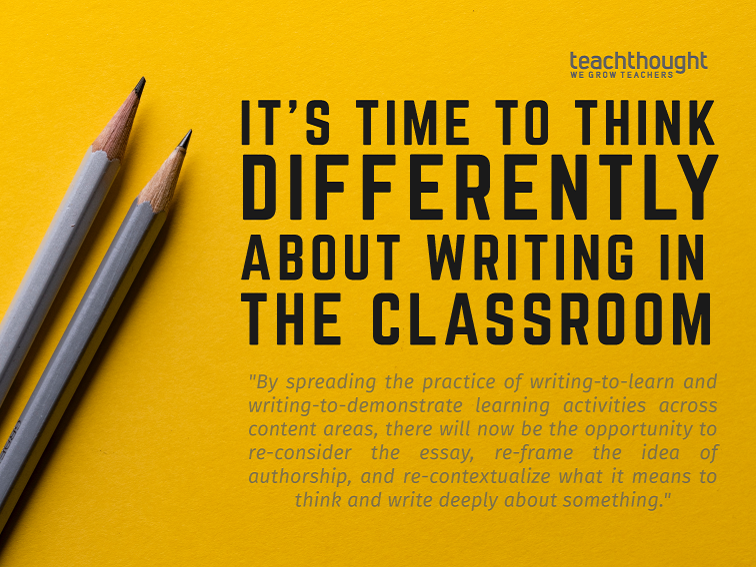
by Terry Heick
Among the biggest changes in modern academic standards is the shift in the burden of general literacy. Rather than only ‘writing teachers,’ teaching reading and writing, now all teachers across all content areas are being asked to do so (something we’ve talked about before).
In the past, literacy—the ability to read, write, and understand—has been the domain of English-Language Arts teachers (and elsewhere in the world, Literature, and Composition teachers).
And this has levied untold damage to student academic progress.
Limiting the craft of writing to a single content area has altered the landscape of students’ minds in ways that are only now being revealed as math teachers are told to teach writing. Students are now used to flinging rudimentary understandings on exit slips in broken sentence fragments, taking notes that neatly curate other people’s ideas, and otherwise ducking the responsibility to craft compelling arguments that synthesize multiple perspectives on a daily basis.
See also An Alternative To Grading Student Writing
So we—English-Language Arts teachers—respond by handing them fill-in-the-blank graphic organizers that coax them to give reason 1 reason 2 and reason 3 in clear sentences that shun complexity or intellectual endurance, provided their ‘writing’ adheres to an expected form.
And handing those same graphic organizers out when other content area teachers ask for resources.
Now, generations later, the idea of writing about math or science seems not just challenging, but forced and awkward. Science and Math, properly taught, are more akin to philosophies and ways of making sense of the world than “content areas,” offering an infinite number of prompts to spur students to write.
Are patterns important in the world today?
How do we create, test, and validate a model?
How do spatial relationships change over time?
In any learning, writing is a seamless fit.
The Erosion Of Content Areas
In our pursuit of efficiency, we have reduced math to a series of equation-solving steps and extended arithmetic. Science has become a perhaps overly-micro study of stuff rather than a system for acquiring knowledge and moving from theory to data.
And here we are, and new standards and expectations are asking all teachers to teach writing. (Perhaps we could make ELA teachers teach Social Studies, and Science teachers teach Math and sufficiently confuse the situation once and for all.)
But worried math and science (or STEM at large) teachers struggling to cover their own academic standards are missing the incredible learning potential that writing has. Few things place the cognitive load on a student that the process of crafting a piece of writing can. And you might notice the idea of craft has shown up a couple of times already—a mix of art and science that’s (not coincidentally) perfectly parallel to the learning process itself.
Dirt and metal.
Color and shape.
Culture and industry.
Learning and education.
Writing is simply thinking with that idea of craft.
It needn’t be some blank, sterile, and academic form that makes students wail and teachers squirm. It’s just a commitment of what you think to paper.
While writing, students are required to put their fingers in their ears and try to wrap their heads around something in a way that not even close-reading can demand. It also has built-in personalization; done well, in writing students make their own hills to climb.
The Problem of Appearance
Sadly, the poor essay has been abused in classrooms for generations, to the point where students think they hate to write.
This is among the most significant barriers to true academic progress schools will have to make in the digital age: Convincing students accustomed to streaming YouTube while texting about an instagram thread on reddit and snarking later about it all on twitter while only burdening themselves with coming up with the most clever of #hashtags that sitting and dwelling with a single media is worth their time.
While English-Language Arts and general writing teachers will still be tasked with the teaching of the parts itself–including the writing process and grammar–spreading the burden of teaching writing across content areas will do a lot of things: increase formal and informal PD resources for all teachers and decrease the jargon that can obscure the teaching of quality writing as it becomes more commonplace.
But more than anything else, by spreading the practice of writing-to-learn and writing-to-demonstrate learning activities across content areas, there will now be the opportunity to reconsider the essay, re-frame the idea of authorship, and re-contextualize what it means to think and write deeply about something.
This is the 21st-century, and 21st-century thinking is different.
While it is full of connectivity and collaboration and stunning possibility, the 21st-century learning era is one of infatuation with image, visual spectacle, flashing alerts, endlessly accessible whimsy, and cognitively stunted communication patterns.
And in capable response, writing could be the answer we’ve been looking for, right beneath our noses the whole time.




